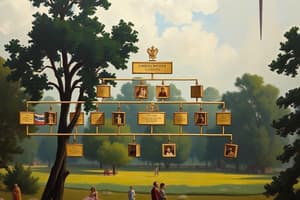Podcast
Questions and Answers
What is a defining characteristic of a horizontal organizational structure?
What is a defining characteristic of a horizontal organizational structure?
- Decentralized decision-making only
- Fewer managerial levels and a wider span of control (correct)
- Focus on top-down communication
- Clear hierarchy with many management levels
Decentralized decision-making gives lower-level managers and employees more authority.
Decentralized decision-making gives lower-level managers and employees more authority.
True (A)
What are the four major elements of the Human Resource Process?
What are the four major elements of the Human Resource Process?
Recruitment, Training, Performance Management, Compensation
The ___ Act outlines the rights and standards for employees in the workplace.
The ___ Act outlines the rights and standards for employees in the workplace.
Match the following compensation types with their descriptions:
Match the following compensation types with their descriptions:
Which of the following is a type of performance appraisal?
Which of the following is a type of performance appraisal?
Labour unions only exist to negotiate employee salaries.
Labour unions only exist to negotiate employee salaries.
What does it mean to delegate in an organizational context?
What does it mean to delegate in an organizational context?
When is a vertical organizational structure typically preferred?
When is a vertical organizational structure typically preferred?
Horizontal structures often promote a clearer chain of command.
Horizontal structures often promote a clearer chain of command.
What is the primary purpose of human resources?
What is the primary purpose of human resources?
The Employment Standards Act outlines the rights of employees regarding ______.
The Employment Standards Act outlines the rights of employees regarding ______.
Match the following types of performance appraisals with their descriptions:
Match the following types of performance appraisals with their descriptions:
Which of the following describes labor unions?
Which of the following describes labor unions?
Decentralized decision-making typically leads to quicker decisions in an organization.
Decentralized decision-making typically leads to quicker decisions in an organization.
What are two examples of non-monetary compensation?
What are two examples of non-monetary compensation?
A horizontal organizational structure typically leads to quicker decision-making processes.
A horizontal organizational structure typically leads to quicker decision-making processes.
What is the primary difference between centralized and decentralized decision-making?
What is the primary difference between centralized and decentralized decision-making?
A business may face a double loss when an employee is ill because it loses productivity and incurs __________ costs.
A business may face a double loss when an employee is ill because it loses productivity and incurs __________ costs.
Which of the following is a major feature of the Human Resource Process?
Which of the following is a major feature of the Human Resource Process?
Match the following types of compensation with their descriptions:
Match the following types of compensation with their descriptions:
What does it mean to be an independent contractor?
What does it mean to be an independent contractor?
What is the Employment Standards Act?
What is the Employment Standards Act?
Flashcards
Horizontal Organizational Structure
Horizontal Organizational Structure
A structure with few layers of management, emphasizing teamwork and collaboration.
Vertical Organizational Structure
Vertical Organizational Structure
A structure with many layers of management, following a clear hierarchy of authority.
Performance Appraisal Types
Performance Appraisal Types
Methods for evaluating employee performance, like ranking, rating scales, and 360-degree feedback.
Employee Compensation
Employee Compensation
Signup and view all the flashcards
Labour Unions
Labour Unions
Signup and view all the flashcards
Independent Contractor
Independent Contractor
Signup and view all the flashcards
Health and Safety Laws
Health and Safety Laws
Signup and view all the flashcards
Delegation
Delegation
Signup and view all the flashcards
Organizational Structure
Organizational Structure
Signup and view all the flashcards
Centralized Decision-Making
Centralized Decision-Making
Signup and view all the flashcards
Decentralized Decision-Making
Decentralized Decision-Making
Signup and view all the flashcards
Human Resource Process
Human Resource Process
Signup and view all the flashcards
Performance Appraisal
Performance Appraisal
Signup and view all the flashcards
Employee Rights
Employee Rights
Signup and view all the flashcards
Horizontal Structure
Horizontal Structure
Signup and view all the flashcards
Vertical Structure
Vertical Structure
Signup and view all the flashcards
Centralized Decisions
Centralized Decisions
Signup and view all the flashcards
Decentralized Decisions
Decentralized Decisions
Signup and view all the flashcards
Study Notes
Organizational Structures
- Organizational structures define how tasks are divided, grouped, and coordinated within an organization.
- Horizontal structures emphasize delegation and teamwork.
- Vertical structures are hierarchical, with clear lines of authority.
Horizontal vs. Vertical Structures
- Horizontal Structures: Decentralized decision-making, flat hierarchy, wider spans of control. Employees have greater autonomy, quicker decision times. Best for dynamic, innovative environments.
- Vertical Structures: Centralized decision-making, tall hierarchy, narrow spans of control. Clear lines of authority, efficient for routine tasks. Best for predictable operations.
Types of Horizontal Structures
- Team-based
- Self-managed teams
- Network structures
Types of Vertical Structures
- Functional
- Divisional
- Matrix
Organizational Structure Use Cases
- Traditional method: Vertical, hierarchical structures.
- Trends: Shifting towards flatter, more horizontal structures.
- Reasons: Adaptability, responsiveness to change, innovation.
Centralized vs. Decentralized
- Centralized: Decisions made at higher levels of management.
- Decentralized: Decisions delegated to lower levels.
Delegation
- Delegation is the assignment of authority and responsibility to a subordinate.
Human Resource Process
- Four major elements include: recruitment, selection, training and development, compensation and benefits.
Purpose of Human Resources
- Ensure effective utilization of the workforce.
- Facilitate compliance with employment legislation.
- Align employee needs with organizational goals.
Performance Appraisals
- Types:
- Ranking/Comparison Method
- Graphic Rating Scale Method
- Behaviorally Anchored Rating Scale (BARS) Method
- 360-degree Feedback Method
- Purpose: Evaluate employee performance, identify strengths and weaknesses, provide feedback.
Labour Unions
- Negotiate collective agreements for wages, benefits, and working conditions for workers.
Compensation
- Compensation refers to all forms of monetary and nonmonetary payments employees receive.
- Examples of monetary compensation include salaries, wages, commissions and bonuses.
- Examples of non-monetary compensation include benefits, recognition, and work flexibility.
Employment Standards Act
- Provides minimum standards for employment conditions.
Employee Rights
- Legal protections against discrimination, harassment, and unsafe working conditions.
Employer Rights
- Rights outlined in legislation to ensure smooth operations including hiring and firing conditions.
Anti-discrimination Laws
- Laws prohibit discrimination based on protected characteristics (e.g., race, religion, gender, etc.).
Affirmative Action
- Policies aimed at increasing representation of underrepresented groups.
Harassment
- Includes any unwelcome conduct based on protected characteristics.
Comparable Worth
- Policies to ensure equal pay for jobs of comparable worth.
Independent Contractor
- Individuals who provide services but are not employees.
Workplace Privacy
- Protecting employees' personal information and confidential communications.
Health and Safety Laws
- Regulations that ensure safe and healthy working conditions.
Double Loss from Illness in Business
- Loss of productivity and potential loss of revenue.
Safety Laws & Regulations
- Canada Labour Code, OHSA (Occupational Health and Safety Act), WSIB (Workplace Safety and Insurance Board) provide guidelines and frameworks.
WSIB
- Manages compensations for workplace injuries and illnesses in Ontario.
Health and Safety Symbols and Colours
- Visual cues used to convey risks and safety information.
Studying That Suits You
Use AI to generate personalized quizzes and flashcards to suit your learning preferences.



